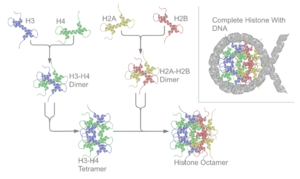Histone facts for kids
Histones are tiny proteins found inside the nucleus of eukaryotic cells (like animal, plant, and fungi cells). Their main job is to help package the very long strands of DNA into smaller, organized units called nucleosomes. Think of them as spools that DNA wraps around.
Histones are a big part of chromatin, which is the material that makes up chromosomes. Without histones, the DNA in our cells would be incredibly long and messy. For example, each human cell has about 1.8 meters (about 6 feet) of DNA! But when it's wrapped around histones, it fits into a space that's only about 90 millimeters (about 3.5 inches) long. This packed DNA then forms chromosomes, which are much smaller and easier for the cell to manage, especially when it divides. Histones also play a role in controlling which genes are turned on or off.
Contents
How Histones Work
Packing Up DNA
Histones act like tiny spools or beads. The long, thin strands of DNA wind tightly around these histone spools. This amazing packing job allows the huge amount of DNA in eukaryotes to fit neatly inside the cell's nucleus. In fact, the DNA molecule becomes about 40,000 times shorter when it's packed by histones! This super-compact structure is essential for cells to function properly.
Controlling Genes
Histones aren't just for packing; they also help control how our genes work. They can change in small ways, which affects how tightly the DNA is wrapped around them. If the DNA is wrapped very tightly, it's harder for the cell to read the genes in that section. If it's looser, the genes are easier to read and use.
These changes to histones are like secret messages that tell the cell what to do. Scientists call this the histone code. This code helps with many important cell processes, such as:
- Controlling which genes are active (turned on) or inactive (turned off).
- Helping to fix damaged DNA.
- Making sure chromosomes are properly condensed when a cell divides (mitosis).
History of Discovery
Histones were first discovered way back in 1884 by a scientist named Albrecht Kossel. For a long time, scientists thought histones were just simple packing material for DNA. They didn't realize how important histones were until the early 1990s. That's when researchers began to discover that histones actually have a big role in controlling our genes and how our cells work.
Histones Across Life
Histones are found in the nuclei of almost all eukaryotic cells, from plants to animals. They are also found in some types of Archaea (tiny single-celled organisms that are different from bacteria). However, you won't find histones in bacteria.
The histone proteins are very similar across many different species. This means their basic structure has been "conserved" over millions of years of evolution. This suggests that histones are incredibly important for the basic biology of the cell nucleus and for life itself.
Images for kids
See also
 In Spanish: Histona para niños
In Spanish: Histona para niños




